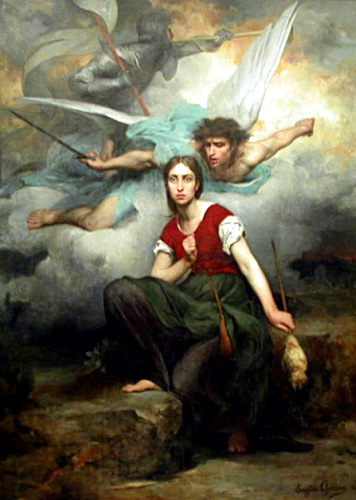The Saint Joan of Arc journey started in Holy Family on 11th March 2009 and is still on going. St Joan of Arc Journey was named after the Saint Joan of Arc, whose Feast Day is 31st May.

Saint Joan of Arc
Saint Joan of Arc, also known as the Maid of Orleans, is a national heroine of France and a Catholic saint. A peasant girl born in eastern France, she led the French army to several important victories during the Hundred Years’ War, claiming divine guidance, and was indirectly responsible for the coronation of Charles VII. She was captured by the English, tried by an ecclesiastical court, and burned at the stake when she was nineteen years old. Twenty-four years later, the Holy See reviewed the decision of the ecclesiastical court, found her innocent, and declared her a martyr. She was beatified in 1909 and later canonized in 1920.
Joan asserted that she had visions from God that told her to recover her homeland from English domination late in the Hundred Years’ War. The uncrowned King Charles VII sent her to the siege at Orléans as part of a relief mission. She gained prominence when she overcame the dismissive attitude of veteran commanders and lifted the siege in only nine days. Several more swift victories led to Charles VII’s coronation at Reims and settled the disputed succession to the throne.
Joan of Arc has remained an important figure in Western culture. From Napoleon to the present, French politicians of all leanings have invoked her memory. Major writers and composers who have created works about her include Shakespeare, Voltaire, Schiller, Verdi, Tchaikovsky, Twain, and Shaw. Depictions of her continue in film, television, video games, song, and dance.
Joan was the daughter of Jacques d’Arc and Isabelle Romée in Domrémy, a village which was then in the duchy of Bar (later annexed to the province of Lorraine and renamed Domrémy-la-Pucelle). Her parents owned about 50 acres (0.2 square kilometers) of land and her father supplemented his farming work with a minor position as a village official, collecting taxes and heading the local watch. They lived in an isolated patch of northeastern territory that remained loyal to the French crown despite being surrounded by Burgundian lands. Several local raids occurred during her childhood and on one occasion her village was burned.
Joan said she was about 19 at her trial, so she was born about 1412; she later testified that she experienced her first vision around 1424 at the age of 12 years when she was out alone in a field and heard voices. She had said she cried when they left as they were so beautiful. She would report that Saint Michael, Saint Catherine, and Saint Margaret told her to drive out the English and bring the Dauphin to Reims for his coronation.
At the age of 16, she asked a kinsman, Durand Lassois, to bring her to nearby Vaucouleurs where she petitioned the garrison commander, Count Robert de Baudricourt, for permission to visit the royal French court at Chinon. Baudricourt’s sarcastic response did not deter her. She returned the following January and gained support from two men of standing: Jean de Metz and Bertrand de Poulengy. Under their auspices, she gained a second interview where she made a remarkable prediction about a military reversal near Orléans.
